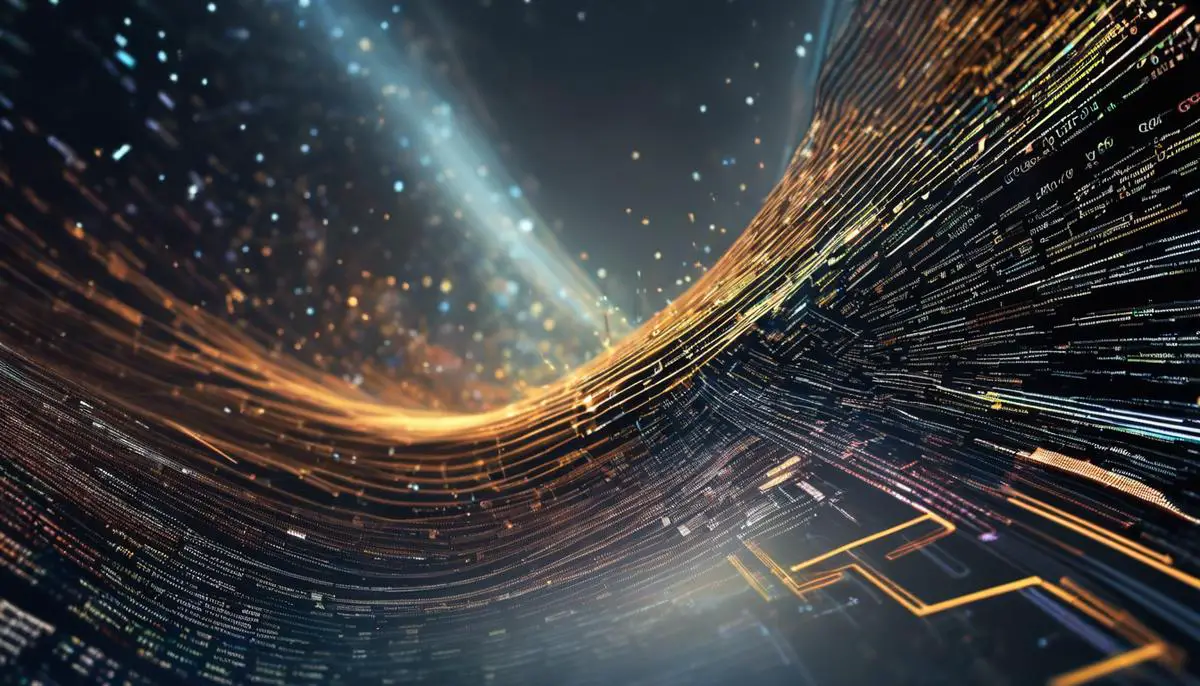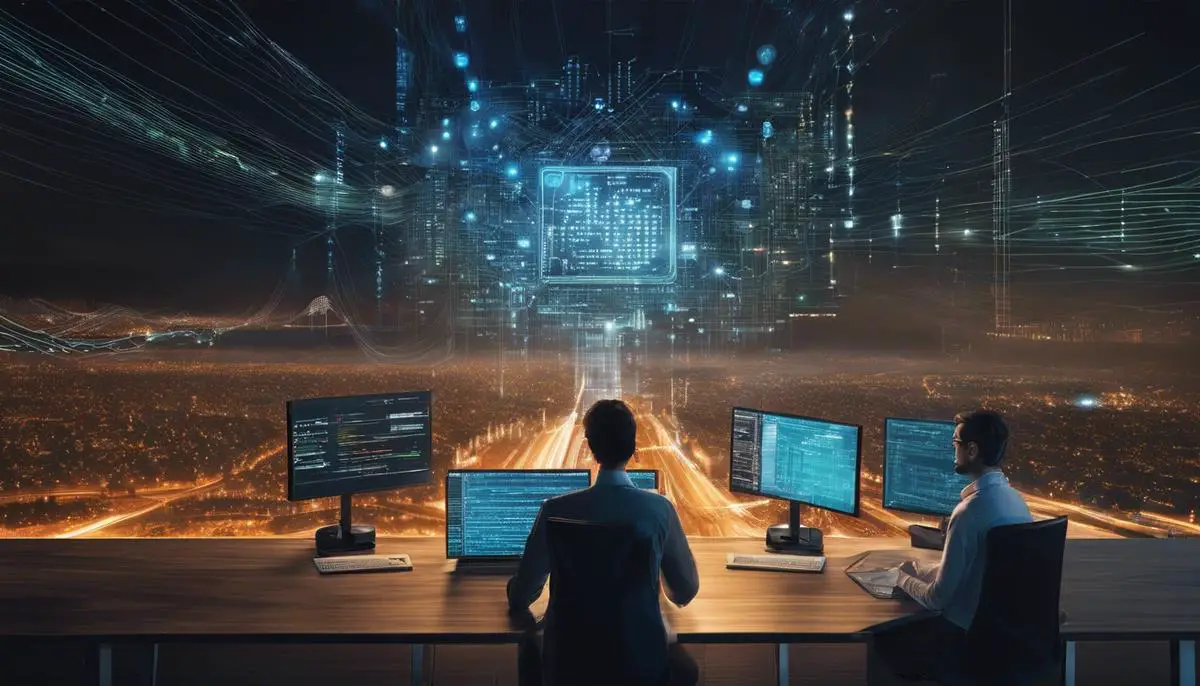Artificial intelligence, an integrated facet of modern life, continues to mark profound transformations in myriad domains, with code translation being one of the most transformative areas. This exploration delves deep into the realm of AI-driven code translators, utilizing machine learning and natural language processing to streamline the intricate process of code translation. The discourse provides a critical analysis of various algorithms used in these systems, providing you with insights into this complex technology. Examining successful applications and case studies of AI in code translation gives an understanding of its real-world impact. Furthermore, spotlighting the challenges and limitations that accompany these technological feats serves as a comprehensive overview of the current industry. Finally, a forward-looking perspective on the future prospects of AI in code translation will craft a layout of the potential growth to be expected in this arena.
Understanding code translators driven by AI
Unraveling the Essentials of AI-Driven Code Translators
Artificial intelligence is progressively reshaping our modern world, permeating virtually every industry and field of study. Among these, code translation is one of the most intriguing applications of AI technology. This fascinating interplay between AI and programming languages seeks not only to change paradigms but also to break down barriers – empowering humans and machines to communicate more effectively.
Code translators, also known as source-to-source compilers, are software tools that convert one high-level programming language into another. Traditional, or manual code translators, rely heavily on the human factor: programmers with comprehensive understanding of both source and target languages are needed to ensure accurate translation. However, the emergence of AI-driven code translators marks a significant evolution in this process.
AI-powered code translators utilize deep learning algorithms to understand and translate code, a complicated process influenced by context, syntax, semantics, and more. These systems are trained with large data sets of programming code in various languages, allowing them to learn and understand the different syntaxes and semantics.
At the heart of AI code translation is the neural machine translation (NMT), a subset of AI that makes use of neural networks to accelerate the process of code translation. By leveraging multiple layers of artificial neural networks, the system learns to make accurate translations based on patterns and structures in the training data.
The effectiveness of AI-driven code translators lies in their ability to ‘learn’. They keep improving through continuous exposure to millions of lines of code. As they grow familiar with more patterns and structures, these translators become more proficient in converting complex strings of code between different programming languages, significantly reducing the risk of error when compared to manual translation.
Another crucial element of AI-powered code translators is their ability to handle code obfuscation. Code obfuscation refers to the transformation of a program into a format that is difficult to disassemble and understand while still retaining its original functionality. Recognizing this obfuscated code, which is often used to protect intellectual property and prevent hacking, is no mean feat without the help of AI.
The intersection of AI and code translation is not just a matter of making machine language more widely accessible. It is about leveraging state-of-the-art technology to break down barriers between different programming languages, and by extension, different cultures and ways of thinking. As AI-driven code translators continue to evolve and improve, they promise to not only streamline and refine programming processes, but also significantly augment human understanding and application of AI itself.

Noteworthy applications and successes of AI in code translation
Prominent Applications of AI in Code Translation
The astounding developments in AI-driven code translators have yielded significant victories that have ushered in a new era of efficiency and accuracy in translating computer code. Among the most prominent applications of AI in code translation is the facilitation of multi-language software development. Programmers around the globe use a wide array of programming languages, and the application of AI in code translation has greatly simplified the process of translating one language into another. This has enabled developers to understand, edit, and execute code written in languages beyond their repertoire, thus expanding their capability to create diverse and cross-functional applications.
Notably, AI-driven code translation has been utilized to enhance legacy system modernization. Outdated programming languages burden businesses with their coarse integration with contemporary systems and vulnerability to cyber threats. However, manual translation from old to new languages is often convoluted and time-consuming. Cue AI-powered code translators, which implement neural networks to analyze, understand, and translate the program logic from an obsolete language to its modern equivalent, significantly reducing the time, costs, and errors associated with manual translations.
Furthermore, AI in code translation has enabled the success of automated testing. This extends not just from code to code translation, but also from human language instructions to code conversion. AI-driven code translators are employed to interpret human language test conditions, converting them into executable test scripts. The result is an expeditious and exact conversion, surpassing manual coding inefficiencies.
AI-driven code translators have also been pivotal in promoting the democratization of programming, supporting initiatives like low-code or no-code platforms. By translating complex programming language commands into simple visual interfaces, AI has made programming far more approachable. Citizen developers can now develop applications even with limited coding knowledge, unlocking technology’s potential to a broader audience.
Moreover, in the domain of cybersecurity, AI-powered translators have made strides in tackling malicious code. By recognizing patterns in the programming, these translators are used to interpret obscure or obfuscated code employed by nefarious programmers to evade detection, thereby strengthening cybersecurity initiatives.
In conclusion, AI in code translation has proven eminently influential, changing the very landscape of software development, testing, modernization, access, and security. While this is only the tip of the iceberg, it undeniably indicates a future where AI-driven code translators take center stage in bridging linguistic gaps in programming. This shift promises a cross-culturally inclusive, efficient, and more secure future for software development, where the essence of code transcends the barriers of language.

Challenges and Limitations in AI-driven code translation
Despite the overarching benefits of AI-driven code translators discussed earlier, it is important to underscore the existing limitations and challenges that inform the ongoing research and development in this field. Though impressive in its self-learning and ever-improving capabilities, AI code translation is not devoid of hurdles or constraints that may inhibit its proficiency and overall application.
Foremost among these challenges is the context-specific nature of code. Unlike natural languages where rules and grammars apply uniformly across different contexts, coding languages do not enjoy such universal jurisdiction. The same code may behave differently in distinct frameworks, introducing a layer of complexity and ambiguity. Machines, despite their computational prowess, can struggle to interpret and adapt to these context-dependent variations, compromising the accuracy of the software translation.
Development of an AI-driven code translator that is equally proficient across multiple programming languages is another daunting challenge. Diverse programming languages often come with distinctive semantics and syntax, making the task of code translation complex. This diversity often demands the deployment of language-specific machine learning models, a constraint that seriously undermines the universality and scalability of this AI application.
AI code translators can also face issues in translating highly abstract or obfuscated code. While previously discussed, the translation of obfuscated code is a pertinent problem yet to be fully resolved. Similarly, abstract code that lacks clear, defined structures can present difficulties for AI translators, hindering the effective translation process.
Additionally, despite advancements in deep learning algorithms and neural machine translation (NMT), one cannot overlook that these technologies are not foolproof. Frequently, they necessitate burgeoning computational resources and expansive data sets, both of which can limit their wider deployment. Furthermore, these systems are often opaque, a property termed as “black-box” in AI parlance, due to their intricately intertwined layers of computation. This makes it challenging to identify and rectify errors, if they occur.
On another note, AI lacks the inherent understanding of the code’s functionality or the underlying intent of the original software developer. This is where human intuition and reasoning outclass AI. Despite the remarkable strides in AI technology, replicating this human-like understanding remains a prodigious challenge.
The landscape of AI-directed code translation is undoubtedly dotted with challenges and limitations. Nevertheless, mindful of these obstacles, dedicated researchers relentlessly trudge the path toward unlocking the full potential of AI in code translation, driven by the promise of enhancing human understanding and application of AI technology.

Future prospects of AI in code translation
The trajectory of AI in code translation promises an affluent future, subtly altering the dynamics of the programming landscape. With robust developments occurring at a fast pace, several intriguing advancements come forth, drawing a formidable sketch of future trends in this realm.
It is anticipated that future advancements will associate AI translators with higher semantic understanding. This implies that these tools would grasp complex programming concepts to facilitate more precise translation. Geo-specific language nuances, operational semantics, and contextual relevance, long deemed the prerogative of human programmers, are poised to be next objectives for AI deep learning algorithms.
Another thrilling speculation revolves around Code Generation Reinforcement Learning (CGRL). This concept anticipates a learning model where AI systems would not just translate, but also generate code by understanding specified requirements. By harnessing Reinforcement Learning, AI systems could discover the best course of action towards code generation, significantly reducing the manual labor in programming.
Furthermore, the advancement of AI-driven code translators will also facilitate the translation of non-traditional language models and encrypted coding languages. Such an evolution could have massive ramifications in cybersecurity, helping developers decrypt complex malicious software codes and build stronger, more adaptive defense systems.
Creative software debugging is another avenue where the future of AI in code translation seems bright. Like a proficient detective, using advanced code translation, AI may identify, interpret, and fix bugs in the source code, proving to be a game-changer in maintaining and upgrading software applications.
Collaborative or swarm coding is another future trend in sight. Drawing inspiration from multi-agent systems, a pool of AI translators could share learning and strategies for a common coding problem. This could remarkably reduce the time and effort of code translation and generation.
Finally, with advances in AI and quantum computing, we could foresee a future where AI-driven code translators could harness quantum algorithms for translating quantum computing instructions for classical computers. This confluence of AI, code translation, and quantum computing could potentially unravel uncharted dimensions in computing power and efficiency.
In conclusion, the road ahead promises fascinating developments in the realm of AI and code translation, unlocking new avenues in software development, debugging, cybersecurity, and quantum computing. Fueled by ceaseless competition of human minds behind the scene, AI is set to revolutionize every corner of our world, carrying us into an era where we witness the blossoming of human creativity unprecedentedly realized through the power of coding.

The transformative power of Artificial Intelligence in code translation is undeniable, as evidenced by various successful applications. The discourse offered a detailed inquiry into the realm of AI-powered code translators, their functioning and applications, and the obstacles they face. Equally important was the discussion on future prospects within this field, emphasizing recent advancements and potential growth areas. It is evident that, while AI-driven code translation poses challenges, it also promises tremendous possibilities for enhancing efficiency, precision and productivity. However, stakeholders must remain cognizant of ethical considerations and address algorithmic bias and reliability issues. Advancements in AI and code translation will undeniably push the boundaries of technology, economy, and social norms, underscoring the need for vigilance and conscious progression.
